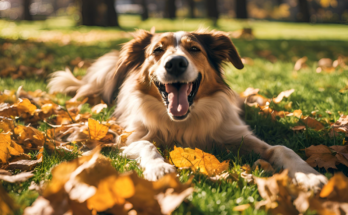Understanding and Managing Grass Allergies in Dogs
Yes, dogs are man’s best friends, but they too have many of the symptoms of allergies, including grass allergies. One of the most mundane forms of allergy that pet owners fail to recognize is a grass allergy and this can cause so much annoyance to a dog. To bring you this extensive article covering all the aspects of this illness, including its causes, signs, diagnosis, available treatments, and measures that can be taken to avoid such a situation with your pet, we’ve compiled a team of specialist veterinarians who are passionate about helping your pet enjoy a fulfilling life with this condition.
What are Grass Allergies in dogs?
Allergic reactions to grass come about when the dog’s body’s immune system is sensitive to the pollen that is produced by grass plants. It is said that this pollen is microscopic, airborne highly mobile, and ubiquitous. Pollen can be ingested, inhaled, through the skin, or when the pollen attaches itself to the fur of the dog or your clothes. Grass allergy can occur any time of the year but is most common in spring and autumn because of the high pollination.
Key Insight: The pollen content from the grass is what makes people develop allergic reactions, not the grass itself. Pollen from other areas can still affect your dog regardless of whether you have eliminated grass from your yard.

Signs That Your Dog Has Allergies to Grass
Diagnosing grass allergies in dogs is not easy because their symptoms are similar to other skin or respiratory ailments such as fleas or dry skin. Here are the most common signs to watch for:
- Persistent Itching and Scratching: Doggies scratch their paws, muzzle, armpits, and tummy.
- Red or Inflamed Skin (Erythema): These symptoms include irritated skin, redness, rash formation, or crust formation on the skin.
- Swollen Paws: The grass allergy causes dogs to Lick their paws and makes them change color from the usual color to redness.
- Runny Nose and Watery Eyes: Some allergies are respiratory and they cause sneezing, and nasal dropping.
- Bald Spots: In severe conditions, frequent scratching results in bald areas on the furred animals.
- Snoring or Wheezing: These symptoms can be caused by an inflammation of the throat or the nostrils.

Causes of Grass Allergies in Dogs
Grass pollen is composed of proteins to which the immune system of certain dogs is sensitive. This activates the release of histamines and hence allergy and inflammation take place. Factors that make dogs more prone to grass allergies include:
- Genetic Predisposition: It affects breeds such as Bulldogs, Retrievers, and Pugs, German Shepherds to mention but a few.
- Environment: As a result of this, residing in regions with high levels of pollen is likely to raise exposure.
- Immune System Sensitivity: Grass allergies can also be developed by dogs with other allergies such as flea or food allergies.
Knowing these causes can assist you in being able to prevent them from arising in the first place.
How to Diagnose Grass Allergies in Dogs
Identifying grass related allergies in dogs is not easy and needs detailed observation accompanied by a veterinarian intervention. If your pet’s signs have become worse during spring and autumn, which is quite common, you should suspect a grass allergy. Here’s how vets typically diagnose it:
- Physical Examination: One common examination that your vet should carry out will be to look for signs of redness, lesions, or scratching.
- Allergy Testing:
- Serum Blood Tests: Performs allergy tests that check for the presence of antibodies in the patient’s blood.
- Intradermal Skin Tests: The standard process used to diagnose topical allergies; the allergens are administered intradermally.
- Exclusion of Other Conditions: Species-specific skin scrapings, flea, and mite stains, or ringworm samples may also be taken.
If your dog has any of these symptoms it must be taken to the vet early enough so that the vet can prescribe the proper medication.
Treatment Options for Grass Allergies in Dogs
Grass allergies in dogs still cannot be eradicated but the signs may be well controlled when a correct management plan has been made. Below are the most effective options:
1. Topical Treatments
- Hypoallergenic Shampoos: These help rid pollen and lessen inflammation on the skin. Oatmeal-based shampoos are preferred by a lot of dog owners.
- Paw Wipes: Before going for a walk, you might bathe your dog or put some water on their paws, or use crushed aloe vera and wipe their paws to remove pollen.
2. Medications
- Antihistamines: Can help reduce sneezing and have ‘runny’ eyes but may not be as useful for skin-related symptoms.
- Cytopoint Injections: A biological therapy that suppresses proteins that cause itch for four to eight weeks.
- Steroids: Specific for severe itching but should not be applied frequently because it is rather dangerous and requires the administration of a veterinarian.
3. Immunotherapy
- Hypersensitivity injections or tablets give your dog tiny portions of allergens over time so the body can adjust. Though time-consuming, the effectiveness of this method can help reduce the symptoms dramatically.
4. Dietary Supplements
- Omega-3 Fatty Acids: Support the health of the skin and decrease inflammation.
- Probiotics: Enhance immune strength that would reduce a dog’s allergic response to allergens.

Preventing Grass Allergies in Dogs
While you can’t completely shield your dog from grass pollen, there are proactive steps to minimize exposure:
- Limit Outdoor Time: Limit the child’s playing time and walk especially during the times of the day when there is a strong wind.
- Clean Your Dog After Walks: Be sure to wash the bottoms of their feet, legs, and fur regularly to rinse off pollen.
- Invest in Protective Gear: Dog boots and light body costumes prevent a dog’s bare paws and belly from directly coming into contact with the allergens.
- Maintain a Clean Home: Clean carpets with a vacuum cleaner or wash your bedding often to leave no room for pollen to accumulate inside the house.
- Regular Grooming: Bathing and brushing your dog washes the pollen stuck on the hair of your dog.

Tips for Managing Grass Allergies Year-Round
Grass allergy in dogs is something that has to be managed constantly. Here are some additional tips to keep your furry friend comfortable:
- Monitor Pollen Levels: Follow guidance for pollen levels online to avoid outside activities during high-risk periods.
- Use Air Purifiers: Housing quality air purifiers to minimize circulating allergic substances in your home.
- Vet Checkups: Failure to observe extreme hygiene will cause your pet to get Secondary infections while you can observe it at a veterinary doctor on routine visits.
Key Insight: Consistency is crucial. Compiling on a schedule will assist in successfully controlling the particular symptoms.
Long-Term Care and Emotional Support for Dogs with Grass Allergies
In captive management, the giver plays an important role but apart from physical treatment, the giver also takes care of the mental and emotional health of the pet. As with other animals, allergies lead to discomfort, frustration or even change in behavior in dogs. Here’s how you can support your dog holistically:
1. Provide Mental Stimulation Indoors
Pollen levels that might limit your time outdoors do not have to limit your dogs’ activity level either. Through treats or toys, training sessions, explore, and chase games such as Jigsaw toys are perfect for a dog to play or exercise.
Key Insight: Lowering the boredom will help decrease stress-induced scratching or licking which is very unproductive to the condition.
2. Maintain Consistent Routines
Dogs thrive on routine. From feeding time to walks to grooming, sticking to a routine can reduce stress in dogs and improve how well they accept the allergy management practices to be put in place. For example, if paw wiping is to be done immediately after the dog returns from a walk, the dog will easily get used to the process.
3. Monitor for Emotional Distress
Prolonged itching or discomfort at any spot in the skin in dogs is likely to cause anxiety and irritability. Look for cues of stress starting from whining, restlessness, and aggression to be sure to seek the services of the vet or an animal behaviorist if this happens.
Pro Tip: Some anxiety tricks include: Ensuring you have a comfortable bed on which you can rest, playing soft background music, or using calming sprays in the room.

Understanding Seasonal vs. Perennial Allergies
When using the term ‘allergens’ it must be noted that allergens such as grass pollen are seasonal while others such as dust mites or mold are perennial. Grass allergies in dogs are usually seasonal, although occur in the winter season while in other cases they are present throughout the year. Of course, it is helpful to know what patterns there are so that you can get prepared for them ahead of time.
- Seasonal Grass Allergy Management: Increase some of the preventions such as indoor cleaning, air purification, and grooming, especially during powder times.
- Perennial Allergy Awareness: If these symptoms are present all year then it is essential that there might be other allergens present. Go to your veterinarian and make an appointment where you will be tested for any allergies to your pet.
Key Insight: Use a diary and record your dog’s behavior paying particular attention to changes depending on the season. This can help your vet in the identification of the problems ailing your dog since the signs may not be very conspicuous.
Grass-Free Alternatives for Outdoor Fun
If avoiding grass is necessary, you can still provide your dog with safe outdoor experiences:
- Artificial Turf: It is a great substitute for natural grass with an appearance and texture that does not contain allergy-causing agents.
- Dog Parks with Paved Areas: Some parks contain no lawns where the dog can play but other prohibited areas where the dog can play.
- Backyard Alternatives: Using gravel, mulch, or other non-pollen forming materials, replace the grass with lawn.
Pro Tip: It is especially important that you wash your dog’s paws after every outdoor activity whether it be on concrete, grass, or dirt.

Monitoring Your Dog’s Progress
Grass allergy is not easy to manage completely. Watch your dog’s symptoms daily and bring changes to their feeding or medication schedule if necessary. Here are key areas to focus on:
- Skin and Coat Condition: Therefore, the changes can be looking for signs such as a decrease in the amount of redness or the frequency of scratching.
- Behavioral Changes: Now you can notice whether your dog is less stressed, anxious, or tense.
- Effectiveness of Treatments: Monitor breast cancer prevention diets and what drugs, supplements, grooming habits, etc., complement or hinder their effectiveness.
Key Insight: Bring your dog in for routine wellness exams to make sure your dog’s allergy plan is still fitting properly.
Final Thoughts
Treating grass allergies in dogs can be somewhat challenging, yet the effort is well deserved. If you know about the condition, are able to prevent flare-ups, and are routinely managing your dog’s grooming and treatment, your furry friend will be able to live comfortably without itchy skin.
Call-to-Action: You can always see your veterinarian for advice if you suspect that your dog might be allergic to grass. However, with proper attention, your pet, however allergic, can lead a happy life with you.
FAQs
1. Can dog grass allergies disappear?
Grass allergies in dogs are almost always permanent but if the allergy is duly managed it will not cause much trouble.
2. What changes can I make to the yard since my dog is now allergic?
It may be advisable to use artificial turf or ground cover with no pollen.
3. Which shampoo is advisable for use on dogs affected by grass?
The best, though not completely accurate, shampoos are hypoallergenic, or those that contain oatmeal. Please consult your vet for more suggestions in this regard.




One Comment on “Grass Allergies in Dogs – Signs, Causes, Diagnosis”